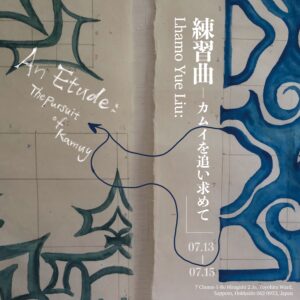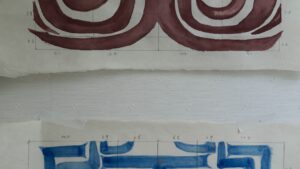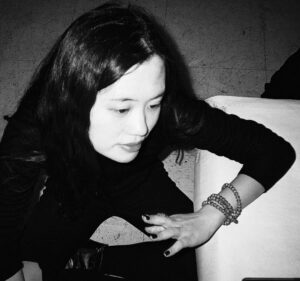Exhibition_ラモ・ユエ・リュウ/Lhamo Yue Liu_ 練習曲:カムイを追い求めて/An Etude: The Pursuit of Kamuy/练习曲:追寻Kamuy

■ ラモ・ユエ・リュウ/Lhamo Yue Liu
■ 会期:2024年7月13日(土)-15日(月・祝)9:00-21:00
■ 会場:天神山アートスタジオ 1階 展示スペース
■ 入場・参加無料
■ 展覧会「練習曲:カムイを追い求めて/An Etude: The Pursuit of Kamuy」について
本展はアーティストが滞在中にアイヌの文様に関する理解を深めていくためにおこなった9枚のドローイングといくつかのスケッチで構成されます。彼女はチベットの計量比率の方法論(造像度量経)を使用し、アイヌの文様を繰り返し学び描くことで、数字と比率の研究を通じて文様の中の神性(カムイ)を探求したいと考えています。
The exhibition consists of 9 paper drawings and several sketches, which are the artist’s
contemplative exercises on Ainu patterns during her residency. She uses the proportion
as methodology to practice Ainu patterns, aiming to explore the divinity (Kamuy) within
the patterns through the study of numbers and measurments.
展览由9幅纸本绘画与若干小稿构成,为艺术家在驻留期间对于阿伊努纹样的体悟练习,她使用比例作为学习方法(《造像度量经)来练习阿伊努纹样,并希望以数字与比例的研究
来寻找纹样中的神性(Kamuy)。
アニミズムはしばしば、今日の人類にもうひとつの可能性–おそらくは出口–を提示してくれる。 アイヌの人々は、カムイを自分たちの周りに存在し、人間に大きな影響を与える様々なものの精霊と呼んでいる。 アイヌの人々は、カムイはあらゆるものの中に存在し、人間を守り、人間が暮らしやすいように手助けをしてくれると信じており、人間は美しい音楽や踊り、リズムに合わせて動く衣服の刺繍などでそれに応える必要があると考えている。 カムイは、植物や動物、火、水、風、山、川、そして私たちが毎日使う道具の中にも存在し、アイヌの人々の文化的図像やアイヌの衣服の模様の中にとらえられ、記録されてきた。 異なるシンボルは異なる意味を持ち、これらの視覚的イメージは衣服に保存され、長い期間にわたって永続することができた。 儀式の一部では、人の動きに合わせて衣服の背中の模様が動くが、これは神への感謝の表現と考えられている。 気になるのは、アイヌの文様が動くことで放出される生命エネルギーとはどのようなものなのか、ということだ。 おそらく文様は、作られた瞬間にラマット(魂)を運ぶ役割を果たすのだろう。
札幌の天神山アートスタジオでの滞在中、私はアイヌ民族の文様を繰り返し研究し、線の動きや色ブロックのメタファーに、このラマート(魂)の存在を見出そうとした。 繰り返し描かれた絵から精神性を測ることに加え、チベットの計量比率の方法論(造像度量経)を応用して、アイヌの古代のトーテムについても学ぼうとした。 伝統的なチベットのタンカ画では、さまざまな彫像が異なる比率を持っており、その比率に従って描かなければならない。 定められた比率は、画家が精神性を再現するための規範であり、対象への敬意を示すものである。 アイヌの衣装に描かれたトーテムにも一定のパターンがあり、滞在中、私はトーテムのパターンを測定して縮尺を決め、線のエネルギーをとらえ、これらの古代のパターンをオオバコ紙に再現して語り直した。
(アイヌ文化に関する考察は、国立アイヌ民族博物館 ウポポイの資料を参考にしました。)
Animism often offers another possibility for today’s human world – perhaps a way out. The Ainu people refer to divinities that have a significant impact on humans in their surroundings as Kamuy. They also believe that Kamuy exists in all things and beings, constantly guarding and helping human life. Humans also need to reciprocate with beautiful music, dancing, and embroidered patterns that rhythmically adorn their clothing. Kamuy exists in animals, plants, fire, water, wind, mountains, rivers, and even in the tools used daily. The Ainu people capture and record Kamuy in their cultural totems and in the patterns of their clothing. Different symbols carry different meanings, and these visual images are preserved on garments, continuing over long periods of time. During certain ceremonies, as the movement of people, the patterns on clothes change. This has been seen as a way to express gratitude to Kamuy. What kind of life energy specific to the Ainu patterns can be released during activities? Perhaps, at the moment the patterns are created, they can serve as vessels for Ramat (soul).
During my residency at Sapporo Tenjin-yama, I repeatedly studied Ainu patterns and tried to find the presence of this Ramat (soul) between the lines and metaphors of color blocks. In addition to measuring the spirituality through repeated drawings, I also attempted to study Ainu’s ancient totems using the methodology of Tibetan proportional measurements (“Sutra of Perfect Enlightenment”). In Tibetan thangka painting tradition, different Buddhas have different proportions, and painters must adhere to these proportions when depicting the Buddhas. The established proportions help the painter reproduce the spiritual code and demonstrate respect for the subject of the painting. Totems on Ainu clothing also follow certain patterns. In my residency practice, I measured and drew proportions of some totem patterns, capturing the energy trends of the lines, reproduced and re-articulate these ancient patterns by using mineral paints on handmade Daphne paper.
泛灵论常常能够为今天的人类世提供另一种可能——也许是一种出路。阿伊努民族将周围存在的各样事物中,对人类产生重要影响的神灵称做Kamuy,阿伊努民族相信Kamuy存在于万物之中,时刻守护、帮助让人类的生活,人类也需要以美丽的音乐舞蹈、衣物上律动起来的刺绣纹样予以回馈。比如动植物、火、水、风、山、河,甚至每日所用的工具中都有Kamuy的存在。Kamuy被阿伊努民族捕捉并记录在他们的文化图腾之中,也在阿伊努人的服饰纹样里。不同符号承载着不同的含义,这些视觉图像在衣物上保留,得以在漫长的时间中延续下来。在一部分的仪式进行中,随着人的活动,衣服背后的纹样也在动,这被看作一种向神灵表达感谢的方式。令我感兴趣的是,阿伊努民族的纹样中具体拥有什么样的生命能量,能够在活动的时候得以释放?也许,纹样在被制造出来的那一刻,就可以作为Ramat(灵魂)的载体。
在札幌天神山的驻地中,我反复学习阿伊努民族的纹样,并尝试在线条的走势、色块的隐喻之间寻找这种Ramat(灵魂)的存在。除了以反复的绘画来度量其中的灵性以外,我也尝试运用西藏的度量比例(《造像度量经》)这一方法论来学习阿伊努古老的图腾。在西藏传统的唐卡绘画中,不同的佛像拥有不同的比例,画师需要谨遵比例进行对佛像的描画。确定的比例是帮助画师再现灵性的密码,也表现了画者对于所画对象的尊重。阿伊努服饰上的图腾也具有一定的规律,在我的驻留实践中,我对其中部分图腾纹样进行测量、比例的绘制,捕捉其中线条的能量走势,将这些古老的纹样在狼毒草纸本上再现、重述。

■ アーティストについて
ユエ・リュウ/Yue Liu(美術)活動拠点 中国
